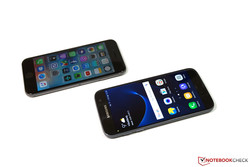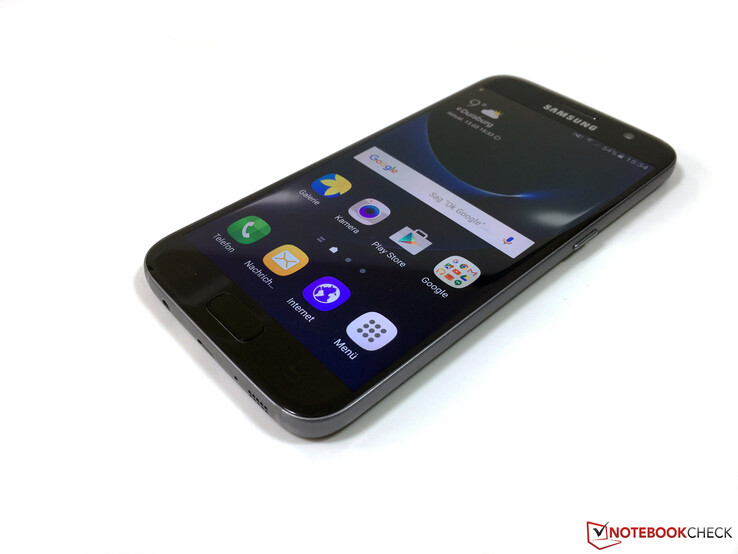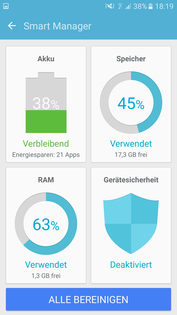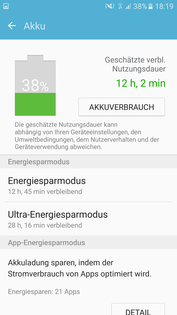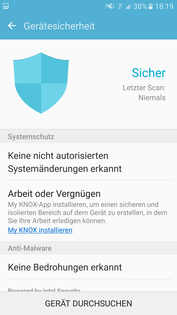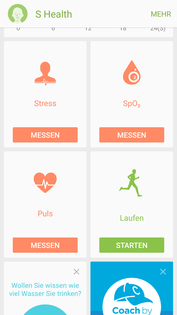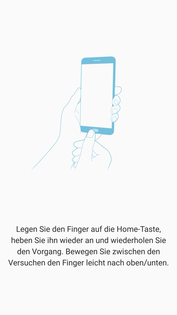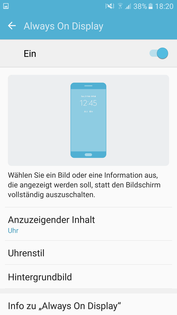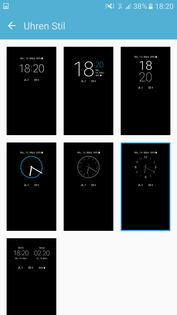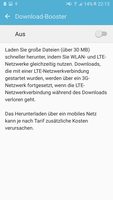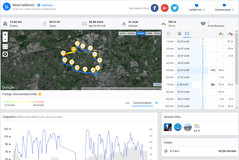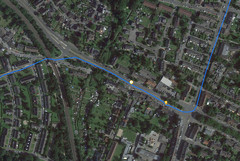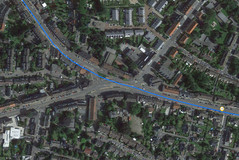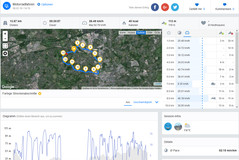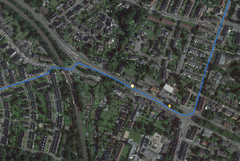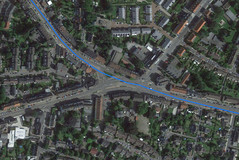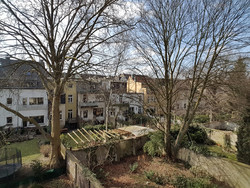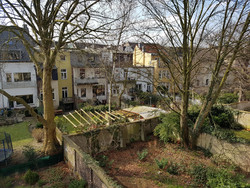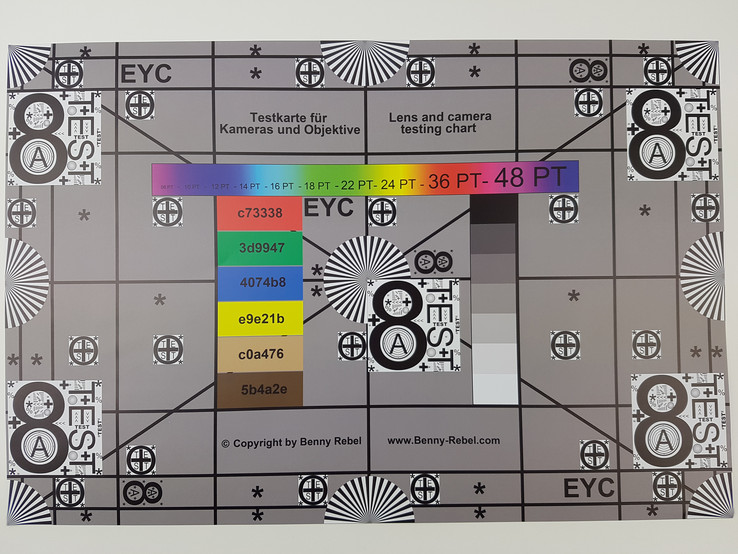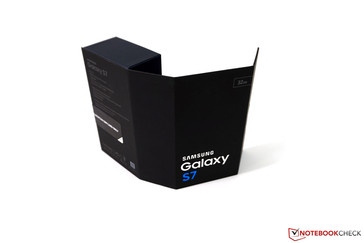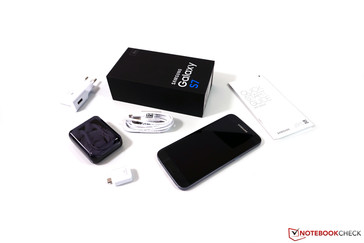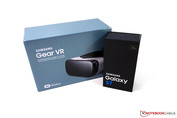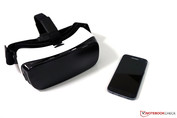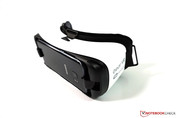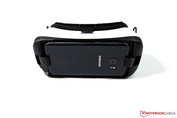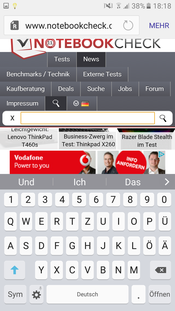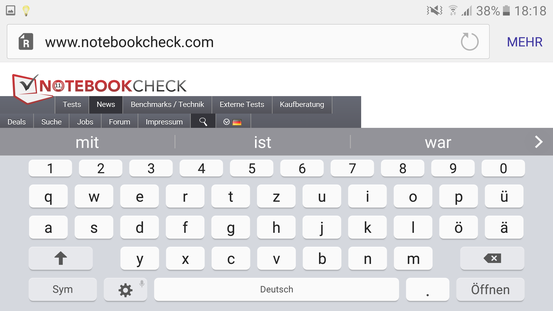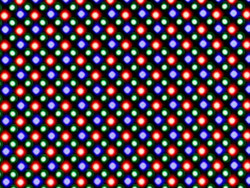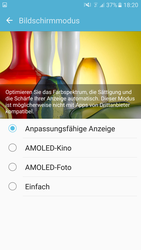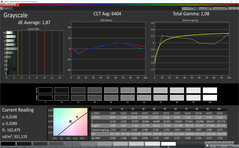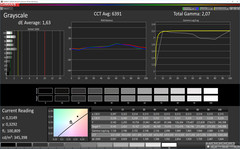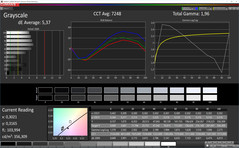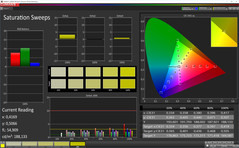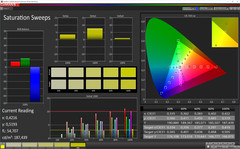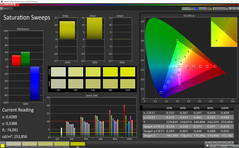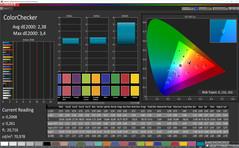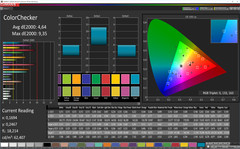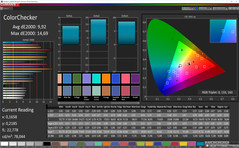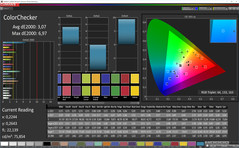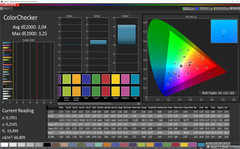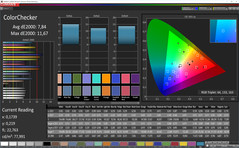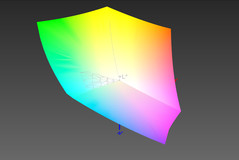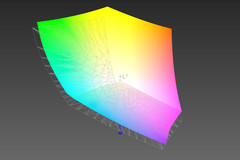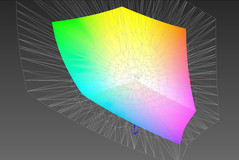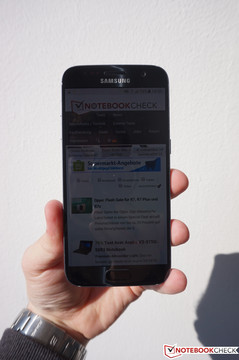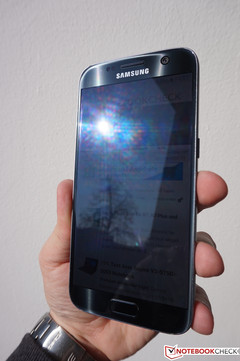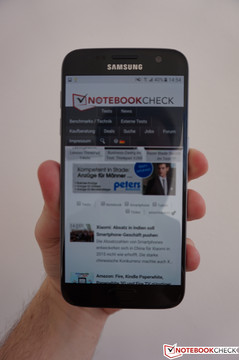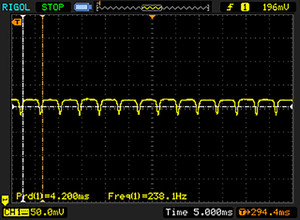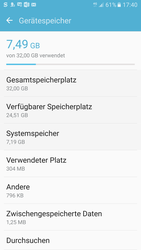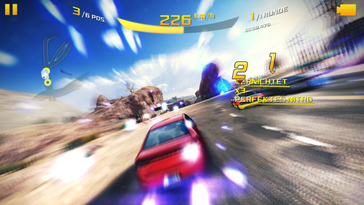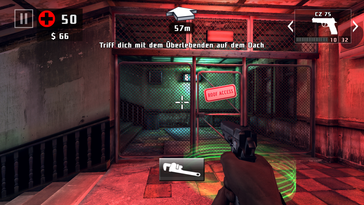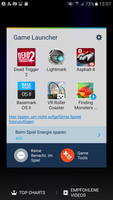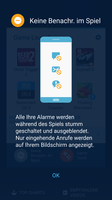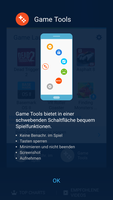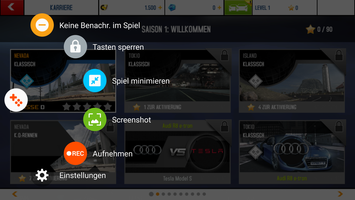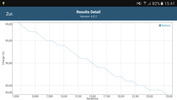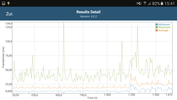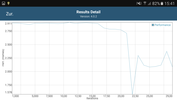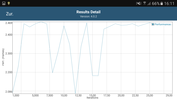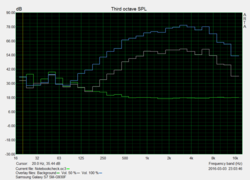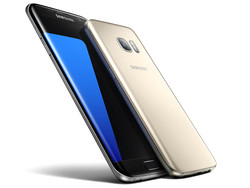Samsung Galaxy S7 Smartphone Review

For the original German review, see here.
Samsung has abandoned the plastic chassis for its high-end devices with the Galaxy S6 series and has introduced an elegant chassis made of metal and glass. However, customers have also lost two characteristic features of the S models in the process: a replaceable battery and expandable storage. Maybe this has also influenced the fact that the sales figures did not live up to the expectations. The manufacturer now makes a step towards the users and once again includes a microSD-slot, and the chassis is – as with the Galaxy S5 – certified according to IP68 (protection against water and dust).
The current generation introduces another change, because the two models Galaxy S7 and Galaxy S7 Edge now come with different screen sizes. While the Galaxy S7 still has a 5.1-inch screen, the S7 Edge has a larger 5.5-inch model. The resolution is still 2560x1440 (QHD) in both cases. Therefore, a larger S7 Edge Plus similar to the S6 generation is rather unlikely. Our test model today is the standard Galaxy S7 with 32 GB of internal storage in the color black-onyx.
So what can potential buyers expect from the Galaxy S7? Obviously the new flagship device has been upgraded to the current Android 6.0 and a faster processor. However, the new camera at the back is of particular interest since the resolution has been reduced to 12 MP, but the new sensor is supposed to take better pictures in low-light situations. Another new feature is the so called Always-On Display. It shows certain information like the clock or the calendar even when the smartphone is in standby mode. The device is also rather thicker this time to accommodate the larger battery. A 3000-mAh module is supposed to increase the runtimes.
Priced at 700 Euros (~$789), the Samsung Galaxy S7 is one of the most expensive premium devices you can get. The main rivals for the normal Galaxy S7 are the "smaller" flagship devices with screen sizes up to 5.2 inches. This list includes the Sony Xperia Z5, the Microsoft Lumia 950, the HTC One M9, Nexus 5X or the Apple iPhone 6s. Larger models such as the Huawei Mate 8, the LG G4, Moto X Style, the Lumia 950 XL or the OnePlus 2 on the other hand will be direct competitors for the Galaxy S7 Edge, but we will also use some of these devices for comparisons in this article.
In addition to the Samsung Galaxy S7, we also had the opportunity to take a look at the Samsung Gear VR headset, which is free when you preorder one of the two Galaxy S7 smartphones. We will also cover this special accessory during this review.
Case
After the chassis was fundamentally changed for the sixth generation, the new Galaxy S7 is more of an evolution. It is still made of metal and glass, which leaves a very sophisticated impression. Probably the most noticeable change is the thicker chassis at 7.9 millimeters (~0.3 in; Galaxy S6: 6.8 mm/~0.27 in). This is mainly a result of the larger battery that needs more space. However, this fact is cleverly concealed: Both edges at the bottom are noticeably rounded, so the smartphone feels really good in the hands. The new generation also weighs slightly more at 152 grams (~5.4 oz; Galaxy S6: 138 grams/~4.9 oz), but this actually adds to the high-quality impression. The thicker chassis has another advantage since the bump of the main camera is now much smaller. The build quality of the smartphone is perfect: Sophisticated materials, careful material transitions and well-integrated physical buttons; only the home button produces a rather loud clicking sound. Once again, the back cover made of Gorilla Glass is a minor problem. It is extremely smooth, so the case can feel rather slippery. The surface also looks rather nasty after a while and you have to clean it regularly. As well as our black model, Samsung also offers the smartphone in white-pearl and gold-platinum.
There is no criticism for the stability, either: Neither pressure nor twisting attempts are a problem for the device. Another advantage over the Galaxy S6 is the IP68 certification against water and dust, which does not require additional covers for the USB port or the SIM slot. According to the manufacturer, you can submerge it for up to 30 minutes in fresh water (up to 1.5 meters/~5 ft deep), so you do not have to worry about it in the rain or in your pool. The SIM slot is now located at the top edge and also accommodates a microSD-card.
The teardown from our iFixit colleagues (we reported) does not rate the Galaxy S7 very well. Compared to the predecessor Galaxy S6, which got 4/10 points, the situation is even worse for the new model. You can replace many components, but accessing them is really tricky. The Galaxy S7 got a total score of 3/10 points.
Despite its 5.1-inch screen, the Galaxy S7 is a rather compact smartphone, which is particularly evident when you compare it with the rival Apple iPhone 6s. Even though the iPhone has only a 4.7-inch screen, it is just barely shorter and narrower.
Connectivity
There are good and bad news about the new Galaxy S7 in this section. Probably the most important feature for customers is the expandable storage, which was sorely missed in the predecessor. You can therefore expand the integrated storage capacity of 32 GB at a comparatively small cost. However, the additional storage cannot be used as integrated storage, even though Android 6 does support this feature. Compatible apps can be transferred to the additional storage after the installation.
But there are also negative aspects: At the bottom is still only a micro-USB 2.0 port, so users have to forego USB-C, USB 3.1, MHL 3.1 or a DisplayPort. The manufacturer has not exhausted all the possibilities at this point, and we would have expected more from a premium device. The micro-USB port is probably used to ensure compatibility with the Gear VR headset, which uses this connector. At least it supports USB-OTG for the easy attachment of USB devices. Wireless connections are possible via Bluetooth 4.2, NFC and Wi-Fi Direct. The infrared transmitter has been waived compared to the predecessor, so you can no longer control your media devices at home with the smartphone.
The home button accommodates the fingerprint scanner and you only have to put your finger on the surface. Due to the comparatively small surface, there can be occasional errors, which are indicated by a small vibration. Overall, however, the sensor was very reliable and very fast during our test. It gets interesting if the scan did not work for five consecutive attempts. The smartphone will be locked for 30 seconds in this case, and you cannot even use your PIN to unlock it during this time.
Software
Samsung ships the Galaxy S7 with the current Android 6.0.1 Marshmallow. As per usual, the manufacturer uses its own TouchWiz user interface, which is hardly different from the predecessor. Overall, the handling is very simple and there are instructions for the wide variety of different functions. Samsung still uses an app drawer. All in all, the UI leaves a good impression, even though the performance is not always perfectly smooth. The launch of the news ticker Upday (swipe to the left, can be deactivated) in particular or the switching between apps did cause occasional stutters.
You can also find the usual Samsung tools preloaded, which can actually be quite useful. One example would be the app S Health, which is particularly handy in combination with the heart rate monitor at the back (oxygen saturation can be measured as well). Samsung also includes some links for popular apps like WhatsApp or Instagram. This is not a problem in general, but you can only deactivate and not remove them. We would have liked more freedom for the user.
Another new feature is the so called Always-On Display. The smartphone can show the clock or a calendar moving across the screen in standby. This feature is quite handy and the smartphone recognizes when the smartphone is in your pocket, for example, and will automatically deactivate the function in this case.
Communication & GPS
The Samsung Galaxy S7 supports LTE Cat. 9 with maximum transfer rates of up to 450 Mbps for downloads (50 Mbps uploads). The signal quality was always comparable to a simultaneously used Apple iPhone 6s in the metropolitan T-Mobile network. The smartphone also works well with wireless home networks and supports fast ac networks in the 5 GHz band. We did not experience any signal issues with our two test routers Fritz!Box 7490 and Asus RT-AC56U. We still had a weak signal two floors below the router, but webpages took noticeably longer to load. All in all, still a good performance. The Galaxy S7 also features the familiar download booster, where the Wi-Fi and the LTE connection can be used simultaneously to accelerate larger downloads (> 30 MB).
You can locate the Galaxy S7 via GPS, GLONASS and BeiDou. We got a signal inside the apartment for a short while, but the accuracy was rather poor in this case. The accuracy was already down to 8 meters (~26 ft) when we were close to a window, and improved by another 2 meters (~6.5 ft) outdoors. We also used the Galaxy S7 for a car ride and compared the results with the professional navigation device Garmin Edge 500. The performance of the smartphone is excellent in general, and the overall track length difference was only 5 meters (~16 ft). There are small shortcuts in difficult situations, where the smartphone does not locate the position quite as often. However, the professional navigation device also has some issues and shows that we drove through the grass strip (third screenshot). There should be no problems when you use the Galaxy S7 for navigation in the car or on a bike.
Telephone & Voice Quality
As with the software, we get the standard phone app from Samsung. It is very simple and offers a large number pad for inputs. You also get a call history, direct access to favorites and obviously the contacts. The voice quality of the Galaxy S7 is positively inconspicuous, because neither we nor our call partners noticed annoying aspects like static or dropouts. The integrated microphone is also very reliable, even though the suppression of background noises could work better. However, it did not affect the understandability. The integrated speaker produces clear voices and hardly distorts at all. The sound is not affected by the position of the speaker when the phone is lying on the table, but this changes once you pick it up. You can accept calls with the provided headset and control the volume. The quality, however, cannot really impress us. You can understand the other person, but voices are slightly distorted, and there is always some quiet static. Handy: The headset does not become knotted thanks to the flat cable.
Cameras & Multimedia
Before we check the main camera, we want to start with the sensor at the front. As with the predecessor, it takes pictures with up to 5 MP (videos in QHD), but the aperture has increased to f/1.7. This helps the low-light quality in particular, where the results are very bright. Picture noise cannot be avoided, but at least you can see many details. Compared to the main sensor at the back, you can notice blurrier details and slightly paler colors in particular. Overall, still a decent performance, especially in low-light situations.
We can find a small surprise at the back, because the resolution has been reduced from 16 to 12 MP in favor of a wider aperture (f/1.7, previously f/1.9) and larger pixels. The results are very impressive. Our review unit is equipped with the sensor from Sony (IMX260), but there are also versions with a sensor from Samsung. Unfortunately, we cannot say if there are differences between the two versions at this point. The pictures of our review unit with the Sony sensor are very sharp, and the colors are conveniently rich as well. You would only want a higher resolution when you start to zoom in. The low-light performance is also very good (scene 3). Once again, we can notice the excellent brightness, which does not affect the picture quality. There is obviously some picture noise, but the quality of the Galaxy S7 certainly does not have to hide behind the competition. The sensor is very fast in good lighting conditions, and it only takes slightly longer in low-light situations.
The camera app is the standard software from Samsung. You can instantly launch the camera with a double tap on the home button (optional). There are numerous picture modes (see screenshots) and you can also download more for free. All the important settings can be changed in the relevant menu. The Pro mode is particularly interesting, where the pictures can also be stored as RAW files. As well as the exposure, ISO number (100-800), shutter speed (1/24000-10) and white balance, you can also apply different filters (like brighter, gentle, nostalgic, lively etc.).
The Live-Broadcast mode should be interesting for some users as well. In combination with YouTube, you can directly stream live videos on YouTube. Panoramas and slow-motions (1280x720, 120 fps) are obviously possible, but the latter quickly tends to flicker.
It is now also possible to create motion shots, where the smartphone records a small video clip right before you hit the trigger. Such shots are marked with an icon in the upper right corner in the gallery. As soon as you press this icon, you can see the short video clip.
Videos can be recorded in 4K (3840x2160, 30 fps), QHD or Full HD. The latter is also the only resolution where the smartphone takes 60 fps videos. However, there are certain limitations for these three resolutions. For instance, it is not possible to take pictures during the recordings, there is no HDR, no video effects and no AF tracking.
The video quality is impressive, especially with the 4K resolution. The camera can also handle faster movements pretty well and the smartphone does not even get lukewarm when you record for extended periods, so there should not be any problems with an overheating device. There is no brightness difference between 4K and FHD videos, but the sensor takes noticeably more time to adjust to changing lighting conditions in FHD 60 fps. One point you should keep an eye on, particularly with 4K videos, is the storage capacity. A 10-minute 4K video has a file size of about 3.2 GB.
Color Accuracy and Sharpness
In addition to our normal sample pictures, we also checked the color accuracy and sharpness under controlled test conditions. The pictures were taken in the Auto mode and there were no changes afterwards, including white balance.
We use the X-Rite ColorChecker Passport to evaluate the color accuracy. The original colors are displayed at the bottom half of every patch. Colors of the Galaxy S7 are a bit too saturated, but this actually helps the rich colors of the pictures. We use our test chart to evaluate the sharpness. If you look very closely, you can notice a slight drop of the sharpness around the edges, but the performance is good in general.
Accessories
The first highlight of the Samsung Galaxy S7 is the new box design. It can be unfolded and leaves a very positive initial impression. Not only does the box include the usual accessories such as the power adapter, USB cable, headset and the service brochures, but also a USB-to-micro-USB adapter. It can be used to attach regular USB devices and also allows data migration from another smartphone – very convenient.
Samsung also offers numerous optional accessories for the Galaxy S7, including different covers. Some of them use integrated additional batteries or keyboards. Furthermore, you can get external battery packs as well as a wireless charging station with quick-charge capabilities. An overview about all products is available here.
Warranty
Samsung offers a 24-month warranty for the Galaxy S7.
Samsung Gear VR
You will get a free Gear VR headset if you have preordered the Samsung Galaxy S7 or S7 Edge. We also had the chance to test the virtual reality headset with the Galaxy S7. The headset is based on the Oculus Rift technology. The display is provided by a compatible Galaxy device (Note 5, S6, S6 Edge, S6 Edge+, S7, S7 Edge) and you cannot use the headset without a corresponding smartphone.
The headset itself, which retails for 99 Euros (~$111), is made of light plastics. At the front is a flexible mount for the smartphone. We would have liked to see a softer material for the clip that mounts the smartphone, because there might be signs of wear at the device after a while.
Before you can use the VR headset, you will have to create an Oculus account in the preloaded app. This process is pretty simple and you can quickly start your VR experience. On the right side of the headset is a touchpad and a Back button; the cursor is controlled via head movements. We recommend you sit on a swivel chair, otherwise you might lose your orientation and hit nearby objects.
The first experiences are actually pretty impressive, because the main menu is already a 360-degree environment. The handling is very intuitive and you should not have any problems if you have used a modern gaming console (PS4 or Xbox One) before. There are several apps to choose from, and some of them are free. 360-degree videos in particular are very enjoyable. It is also possible to attach a gamepad when you play games.
However, there are also some restrictions. The Gear VR does not work with glasses. The resolution is also a minor issue. Every eye can see a picture with roughly 1280x1440 pixels, so the images are not really sharp, particularly in the peripheral areas. Some users also complain about headaches or motion sickness, especially in the fast sections. Right now, the headset is a nice gadget, and the available contents are still limited, but we think that it is a good addition to Galaxy smartphones considering the price of 99 Euros (~$111).
Input Devices & Handling
The first thing we noticed was the extremely sensitive touchscreen. Even simple scrolling repeatedly triggered unwanted actions. This means that you must not apply a lot of pressure, and you have to get used to it. The sensitivity of the touchscreen was also evident when we took the pictures of the Galaxy S7. Even a small drop of water we poured over the display was sufficient to launch an app on the home screen. Unfortunately, there is no setting to reduce the sensitivity.
Nevertheless, the touchscreen provides good gliding capabilities and recognizes up to 10 inputs simultaneously. The physical buttons are integrated well, and do not clatter. The volume rocker and the power button have a firm pressure point with a short travel, the clicking noise in not too loud and suits the sophisticated impression of the device. Only the home button underneath the display cannot quite keep up with that the rest. It is also well-integrated, but produces a much louder clicking noise. The home button is flanked by two illuminated Android sensor buttons, but you cannot change their allocation.
The virtual keyboard is the standard model from Samsung. It offers all the standard features such as word predictions, spell check and swipe inputs, even though the latter has to be activated in the settings first. Above the regular keys is a smaller row with numbers.
Display
As with the predecessor, Samsung has equipped the Galaxy S7 with a 5.1-inch SAMOLED panel with a high resolution of 2560x1440 pixels. This results in an extremely high pixel density of 576 PPI. The Ultra-HD resolution is not available, but this is not an issue in our opinion. The display is very sharp and you cannot see individual pixels.
We can measure am maximum brightness of 354 cd/m² for the Galaxy S7 with a pure white background, but the value is increased to a very good 489 cd/m² with an even distribution of black and white picture contents (APL50). It gets really bright when you use the light sensor, because the review unit will reach up to 684 cd/m² in this case and can even beat the Sony Xperia Z5. Thanks to the black value of 0.0 cd/m², you get an excellent contrast ratio. Subjectively, we are very impressed by the display.
| |||||||||||||||||||||||||
Brightness Distribution: 98 %
Center on Battery: 350 cd/m²
Contrast: ∞:1 (Black: 0 cd/m²)
ΔE ColorChecker Calman: 2.04 | ∀{0.5-29.43 Ø4.78}
ΔE Greyscale Calman: 1.63 | ∀{0.09-98 Ø5}
99.35% sRGB (Argyll 1.6.3 3D)
86.86% AdobeRGB 1998 (Argyll 1.6.3 3D)
99.2% AdobeRGB 1998 (Argyll 3D)
99.3% sRGB (Argyll 3D)
88.8% Display P3 (Argyll 3D)
Gamma: 2.07
CCT: 6391 K
| Samsung Galaxy S7 SAMOLED, 5.1" | Sony Xperia Z5 IPS, 5.2" | Apple iPhone 6S IPS, 4.7" | Microsoft Lumia 950 AMOLED, 5.2" | HTC One M9 Super LCD 3, 5" | Google Nexus 5X IPS, 5.2" | Samsung Galaxy S6 Super-AMOLED, 5.1" | |
|---|---|---|---|---|---|---|---|
| Screen | -141% | -21% | -16% | -80% | 11% | -19% | |
| Brightness middle (cd/m²) | 350 | 669 91% | 552 58% | 292 -17% | 474 35% | 503 44% | 335 -4% |
| Brightness (cd/m²) | 351 | 624 78% | 549 56% | 298 -15% | 458 30% | 498 42% | 345 -2% |
| Brightness Distribution (%) | 98 | 85 -13% | 87 -11% | 92 -6% | 85 -13% | 97 -1% | 89 -9% |
| Black Level * (cd/m²) | 0.68 | 0.39 | 0.4 | 0.38 | |||
| Colorchecker dE 2000 * | 2.04 | 7.96 -290% | 3.4 -67% | 2.48 -22% | 6.32 -210% | 2.09 -2% | 2.51 -23% |
| Colorchecker dE 2000 max. * | 3.25 | ||||||
| Greyscale dE 2000 * | 1.63 | 10.95 -572% | 4.16 -155% | 1.97 -21% | 6.36 -290% | 2.12 -30% | 2.59 -59% |
| Gamma | 2.07 106% | 2.61 84% | 2.21 100% | 2.06 107% | 2.43 91% | 2.27 97% | 2.43 91% |
| CCT | 6391 102% | 7402 88% | 7288 89% | 6640 98% | 8218 79% | 6621 98% | 6424 101% |
| Color Space (Percent of AdobeRGB 1998) (%) | 86.86 | 62.18 -28% | 58.81 -32% | ||||
| Color Space (Percent of sRGB) (%) | 99.35 | 95.93 -3% | |||||
| Contrast (:1) | 984 | 1415 | 1185 | 1324 |
* ... smaller is better
As per usual, you get different picture modes for the SAMOLED panel. In addition to an adjustable display, which adapts to the display content, you can choose between AMOLED Cinema, AMOLED Photo and Simple. We prefer a natural presentation, which is provided by AMOLED Photo. Here we can measure excellent values for the colors as well as the grayscale. The average DeltaE-2000 deviations are just 2.07 for the colors (compared to the AdobeRGB color space) and 1.63 for the grayscale (sRGB reference color space). The ideal values are less than 3. Within the comparison, only the Microsoft Lumia 950 and the Google Nexus 5X can keep up with this performance.
We also checked the color space coverages – and once again, the results are very good. The sRGB color space is almost covered completely, and the more demanding AdobeRGB reference by almost 87%. All in all, Samsung was able to improve the display even further, and it is one of the best smartphone displays you can currently get.
Thanks to the very high luminance with the activated light sensor and the excellent contrast, it is easy to use the Galaxy S7 outdoors. The first two pictures represent the worst-case scenario on a very bright day under direct sunlight. However, every device with a glossy screen would struggle in this scenario. There are no restrictions in the shade.
Screen Flickering / PWM (Pulse-Width Modulation)
| Screen flickering / PWM detected | 238.1 Hz | ≤ 100 % brightness setting | |
The display backlight flickers at 238.1 Hz (worst case, e.g., utilizing PWM) Flickering detected at a brightness setting of 100 % and below. There should be no flickering or PWM above this brightness setting. The frequency of 238.1 Hz is relatively low, so sensitive users will likely notice flickering and experience eyestrain at the stated brightness setting and below. In comparison: 53 % of all tested devices do not use PWM to dim the display. If PWM was detected, an average of 8111 (minimum: 5 - maximum: 343500) Hz was measured. | |||
Our picture shows that the viewing angle stability of the Galaxy S7 is excellent. You can even see the content from extreme angles without a contrast drop. However, we did notice a slight blue discoloration of bright surfaces when the angle exceeded around 30 degrees (in all directions), but there are no restrictions in practice.
Performance
Samsung offers two versions of the Galaxy S7. While the European model is equipped with Samsung's own Exynos 8890 Octa SoC, Mali-T880 MP12 GPU and 4 GB of RAM, the U.S. model is powered by the Snapdragon 820 with an Adreno 530 GPU. To get an idea of the performance of the Galaxy S7 with the Snapdragon 820, we will use a development platform for our benchmarks. We were able to test this model during a benchmark event hosted by Qualcomm.
The Samsung Exynos 8890 Octa is a modern SoC with eight cores, which was announced at the end of 2015 and the Galaxy S7 is the first device that uses this chip. It consists of two clusters with four cores each. One cluster consists of four Samsung M1 cores. Two of them can reach up to 2.6 GHz (4 cores: up to 2.3 GHz). The other cluster uses four frugal Cortex-A53 cores clocked at up to 1.6 GHz. They primarily handle simple tasks.
We start with the evaluation of the CPU performance and can immediately see that the Exynos 8890 is one of the fastest chips. It can even manage the top spot in Geekbench Multi. The result is also very good when we stress only one core, but it falls behind the Apple A9 inside the iPhone 6s and the Snapdragon 820. This means that the U.S. model of the Galaxy S7 as well as the upcoming flagship smartphones from LG and HTC could have an advantage.
| AnTuTu v5 - Total Score | |
| Samsung Galaxy S7 | |
| Samsung Galaxy S6 Edge | |
| Samsung Galaxy S6 | |
| Apple iPhone 6S | |
| OnePlus 2 | |
| Google Nexus 5X | |
| AnTuTu v6 - Total Score | |
| Qualcomm Snapdragon 820 MDP | |
| Samsung Galaxy S7 | |
| Huawei Mate 8 | |
| OnePlus 2 | |
| Geekbench 3 | |
| 32 Bit Multi-Core Score | |
| Samsung Galaxy S6 | |
| Samsung Galaxy S6 Edge | |
| OnePlus 2 | |
| 32 Bit Single-Core Score | |
| Samsung Galaxy S6 Edge | |
| Samsung Galaxy S6 | |
| OnePlus 2 | |
| 64 Bit Multi-Core Score | |
| Samsung Galaxy S7 | |
| Huawei Mate 8 | |
| Samsung Galaxy S6 Edge | |
| Qualcomm Snapdragon 820 MDP | |
| OnePlus 2 | |
| Apple iPhone 6S | |
| Google Nexus 5X | |
| 64 Bit Single-Core Score | |
| Apple iPhone 6S | |
| Qualcomm Snapdragon 820 MDP | |
| Samsung Galaxy S7 | |
| Huawei Mate 8 | |
| Samsung Galaxy S6 Edge | |
| Google Nexus 5X | |
| OnePlus 2 | |
| PCMark for Android | |
| Work 2.0 battery life | |
| Samsung Galaxy S7 | |
| Work 2.0 performance score | |
| Huawei Mate 8 | |
| Samsung Galaxy S7 | |
| Work performance score | |
| Huawei Mate 8 | |
| Qualcomm Snapdragon 820 MDP | |
| Samsung Galaxy S6 Edge | |
| Samsung Galaxy S7 | |
| Google Nexus 5X | |
| OnePlus 2 | |
This trend also continues in the GPU benchmarks. The Mali-T880 MP12 is sometimes twice as fast as the Galaxy S6 in the demanding graphics tests, but the Adreno 530 of the Snapdragon 820 is another 15 to 20% faster. All in all, the Galaxy S7 is still one of the fastest devices, and the GPU performance is sufficient for all modern games. The GPU also supports the new Vulkan API, but there are no corresponding apps yet (except for some betas).
| GFXBench | |
| on screen Car Chase Onscreen | |
| OnePlus 2 | |
| Qualcomm Snapdragon 820 MDP | |
| Samsung Galaxy S7 | |
| Huawei Mate 8 | |
| 1920x1080 Car Chase Offscreen | |
| Qualcomm Snapdragon 820 MDP | |
| Samsung Galaxy S7 | |
| OnePlus 2 | |
| Huawei Mate 8 | |
| GFXBench 3.1 | |
| on screen Manhattan ES 3.1 Onscreen | |
| OnePlus 2 | |
| Qualcomm Snapdragon 820 MDP | |
| Samsung Galaxy S7 | |
| Huawei Mate 8 | |
| Samsung Galaxy S6 Edge | |
| 1920x1080 Manhattan ES 3.1 Offscreen | |
| Qualcomm Snapdragon 820 MDP | |
| Samsung Galaxy S7 | |
| OnePlus 2 | |
| Samsung Galaxy S6 Edge | |
| Huawei Mate 8 | |
| GFXBench 3.0 | |
| on screen Manhattan Onscreen OGL | |
| Apple iPhone 6S | |
| Qualcomm Snapdragon 820 MDP | |
| Samsung Galaxy S7 | |
| OnePlus 2 | |
| Huawei Mate 8 | |
| Google Nexus 5X | |
| Samsung Galaxy S6 | |
| Samsung Galaxy S6 Edge | |
| 1920x1080 1080p Manhattan Offscreen | |
| Qualcomm Snapdragon 820 MDP | |
| Samsung Galaxy S7 | |
| Apple iPhone 6S | |
| Samsung Galaxy S6 Edge | |
| OnePlus 2 | |
| Samsung Galaxy S6 | |
| Huawei Mate 8 | |
| Google Nexus 5X | |
| GFXBench (DX / GLBenchmark) 2.7 | |
| T-Rex Onscreen | |
| Apple iPhone 6S | |
| Qualcomm Snapdragon 820 MDP | |
| Samsung Galaxy S7 | |
| OnePlus 2 | |
| Huawei Mate 8 | |
| Google Nexus 5X | |
| Samsung Galaxy S6 Edge | |
| Samsung Galaxy S6 | |
| 1920x1080 T-Rex Offscreen | |
| Qualcomm Snapdragon 820 MDP | |
| Samsung Galaxy S7 | |
| Apple iPhone 6S | |
| Samsung Galaxy S6 Edge | |
| OnePlus 2 | |
| Samsung Galaxy S6 | |
| Huawei Mate 8 | |
| Google Nexus 5X | |
| Basemark ES 3.1 / Metal - offscreen Overall Score | |
| Apple iPhone 6S | |
| Samsung Galaxy S7 | |
| OnePlus 2 | |
| Huawei Mate 8 | |
| Lightmark - 1920x1080 1080p | |
| Qualcomm Snapdragon 820 MDP | |
| OnePlus 2 | |
| Samsung Galaxy S7 | |
| Samsung Galaxy S6 Edge | |
| Huawei Mate 8 | |
| Epic Citadel - Ultra High Quality | |
| OnePlus 2 | |
| Huawei Mate 8 | |
| Samsung Galaxy S7 | |
| Samsung Galaxy S6 Edge | |
Apple is still the benchmark in terms of the browsing performance and can clearly win all the tests (+10 to 60%). But the Galaxy S7 does not have to hide since it is the fastest Android we could test so far. The Snapdragon 820 with Qualcomm's own browser was usually slower than our review unit and only slightly faster in Mozilla Kraken 1.1.
Subjectively, there were no limitations when we browsed the web. Assuming you have a fast data connection, you can enjoy fast loading of web pages and a smooth handling.
| Octane V2 - Total Score | |
| Apple iPhone 6S | |
| Samsung Galaxy S7 | |
| Huawei Mate 8 | |
| Qualcomm Snapdragon 820 MDP | |
| Qualcomm Snapdragon 820 MDP | |
| Samsung Galaxy S6 Edge | |
| Samsung Galaxy S6 | |
| Google Nexus 5X | |
| OnePlus 2 | |
| Mozilla Kraken 1.1 - Total | |
| OnePlus 2 | |
| Qualcomm Snapdragon 820 MDP | |
| Qualcomm Snapdragon 820 MDP | |
| Google Nexus 5X | |
| Samsung Galaxy S6 Edge | |
| Huawei Mate 8 | |
| Samsung Galaxy S7 | |
| Apple iPhone 6S | |
| WebXPRT 2015 - Overall | |
| Apple iPhone 6S | |
| Samsung Galaxy S7 | |
| Huawei Mate 8 | |
| Qualcomm Snapdragon 820 MDP | |
| Google Nexus 5X | |
| OnePlus 2 | |
| JetStream 1.1 - Total Score | |
| Apple iPhone 6S | |
| Samsung Galaxy S7 | |
| Huawei Mate 8 | |
| Qualcomm Snapdragon 820 MDP | |
| Qualcomm Snapdragon 820 MDP | |
| Samsung Galaxy S6 | |
| Samsung Galaxy S6 Edge | |
| Google Nexus 5X | |
| OnePlus 2 | |
* ... smaller is better
Like the predecessor Galaxy S6, Samsung once again uses modern UFS 2.0 flash storage for the new Galaxy S7, but the performance is even higher this time. Thanks to sequential transfer rates of almost 500 MB/s (read) and 150 MB/s (write), the test model can easily take the lead. The 4K Read performance, which is very important in practice, is also very impressive with around 100 MB/s, only the write performance (Random Write 4K) of the current model is slightly behind the predecessor.
You can use around 24.5 GB of the 32 GB storage capacity after the initial setup. Many users will therefore use a microSD-card (up to 200 GB) to expand the storage, so we checked the performance of the SD-card reader. Our reference card Toshiba Exceria Pro M401 manages up to 95/80 MB/s (read/write) according to the manufacturer. We can determine good results of 72 and 53 MB/s for the Galaxy S7, so you do not have to worry about the performance. We have already mentioned that the additional storage cannot be used as internal storage, but App2SD works with compatible apps.
| AndroBench 3-5 | |
| Sequential Write 256KB SDCard | |
| Samsung Galaxy S7 | |
| Sequential Read 256KB SDCard | |
| Samsung Galaxy S7 | |
| Random Write 4KB | |
| Samsung Galaxy S6 | |
| Samsung Galaxy S6 Edge | |
| Samsung Galaxy S7 | |
| Huawei Mate 8 | |
| OnePlus 2 | |
| Qualcomm Snapdragon 820 MDP | |
| Google Nexus 5X | |
| Random Read 4KB | |
| Qualcomm Snapdragon 820 MDP | |
| Samsung Galaxy S7 | |
| Samsung Galaxy S6 | |
| Samsung Galaxy S6 Edge | |
| Huawei Mate 8 | |
| Google Nexus 5X | |
| OnePlus 2 | |
| Sequential Write 256KB | |
| Samsung Galaxy S7 | |
| Qualcomm Snapdragon 820 MDP | |
| Samsung Galaxy S6 Edge | |
| Samsung Galaxy S6 | |
| OnePlus 2 | |
| Huawei Mate 8 | |
| Google Nexus 5X | |
| Sequential Read 256KB | |
| Samsung Galaxy S7 | |
| Qualcomm Snapdragon 820 MDP | |
| Samsung Galaxy S6 Edge | |
| Samsung Galaxy S6 | |
| Google Nexus 5X | |
| Huawei Mate 8 | |
| OnePlus 2 | |
Games
The Exynos 8890 Octa SoC and the Mali-T880 MP12 GPU are powerful enough for modern games, even at the high resolution of 2560x1440 pixels. This means that you can even play demanding games such as “Dead Trigger 2” or “Asphalt 8: Airborne” without any problems. Once again, we noticed the sensitive touchscreen during gaming, so there were sometimes accidental inputs. The speaker at the bottom is also quickly covered by the fingers when you play in landscape mode.
Samsung has implemented two additional features for the gaming experience. They are called Game Launcher and Game Tools. We do not really know why they are deactivated by default, but you can activate them in the settings. The game launcher is a central hub for all your installed games, and there are some settings. You can, for instance, adjust the power settings or deactivate notifications while you play. Game Tools are also interesting and can be activated via overlay when you play. It is, for example, possible to deactivate the sensor buttons or take screenshots/videos.
| Asphalt 8: Airborne | |||
| Settings | Value | ||
| high | 30 fps | ||
| Dead Trigger 2 | |||
| Settings | Value | ||
| high | 56 fps | ||
Emissions
Temperature
The Galaxy S7 leaves an excellent impression in terms of the surface temperatures. It does not even get lukewarm while idling or light workloads and we can only measure up to 38.1 °C (~101 °F) on one spot under maximum load. This is perceptible, but certainly not distracting.
Are the low surface temperatures a result of reduced performance? We check this with the GFXBench battery test, which repeats the T-Rex test thirty times consecutively and logs the performance as well as the temperatures. The temperature diagrams for the Galaxy S7 stayed empty though. We can see that the performance drops by around 50% after the first 15 runs (~14 minutes) and then levels off at around 80% of the original capacity. We immediately ran the test for a second time. Once again, the performance fluctuated and levelled off at 75 to 85% performance of the original performance. Due to the enormous graphics performance, there should not be any problems when you play games, but the situation could change when you run complex VR applications that really stress the hardware.
(+) The maximum temperature on the upper side is 38.3 °C / 101 F, compared to the average of 35.2 °C / 95 F, ranging from 21.9 to 247 °C for the class Smartphone.
(+) The bottom heats up to a maximum of 37.6 °C / 100 F, compared to the average of 34 °C / 93 F
(+) In idle usage, the average temperature for the upper side is 29 °C / 84 F, compared to the device average of 32.9 °C / 91 F.
Speakers
The mono speaker at the lower edge of the case can be really loud at up to 87 dB(A). Even music playback still sounds okay at this volume, because there are no noteworthy distortions. As expected, there is no bass and the sound tends to put too much emphasis on the high tones. By the way, Samsung's own music app is not preloaded, but is available for free in the store Galaxy Apps. You can only use Google Music by default. Unfortunately, additional software to tune the sound is not available, either.
The playback at the 3.5 mm stereo jack is okay. The maximum volume is sufficient for normal headphones. However, we are not completely satisfied by the performance, because even high-quality songs lack dynamics. We have already heard better results, one example would be the HTC One A9.
The connection with a Bluetooth speaker (Denon Envaya Mini) was established without any problems, and there were no annoying dropouts during the playback. The range was decent as well (~10 meters/~33 ft).
Energy Management
Power Consumption
The power consumption of the Samsung Galaxy S7 is low for such a powerful smartphone. Our comparison table should only be used as an indicator, because not all devices were tested with the same equipment. In addition to the standby consumption, we also checked the impact of the Always-On Display. With the calendar active, the consumption constantly fluctuated between 0.24 and 0.6 watts. This is actually noticeable. We let the fully charged smartphone rest in standby overnight (no push notifications), and the battery capacity was 10% lower after around 6 hours.
The Galaxy S7 comes with a 10-watt power adapter, which supports quick charging. It can fully recharge the smartphone within 1.5 hours.
| Off / Standby | |
| Idle | |
| Load |
|
Key:
min: | |
| Samsung Galaxy S7 Samsung Exynos 8890 Octa, 5.1" | Sony Xperia Z5 Qualcomm Snapdragon 810 MSM8994, 5.2" | Apple iPhone 6S Apple A9, 4.7" | Microsoft Lumia 950 Qualcomm Snapdragon 808 MSM8992, 5.2" | HTC One M9 Qualcomm Snapdragon 810 MSM8994, 5" | Google Nexus 5X Qualcomm Snapdragon 808 MSM8992, 5.2" | Samsung Galaxy S6 Samsung Exynos 7420 Octa, 5.1" | |
|---|---|---|---|---|---|---|---|
| Power Consumption | -34% | -4% | -104% | -65% | -19% | 15% | |
| Idle Minimum * (Watt) | 0.68 | 0.7 -3% | 0.5 26% | 1.97 -190% | 1.1 -62% | 0.55 19% | 0.4 41% |
| Idle Average * (Watt) | 1.02 | 1.7 -67% | 1.6 -57% | 2.42 -137% | 2 -96% | 1.44 -41% | 0.6 41% |
| Idle Maximum * (Watt) | 1.14 | 1.8 -58% | 1.9 -67% | 2.96 -160% | 2.4 -111% | 1.9 -67% | 1.2 -5% |
| Load Average * (Watt) | 4.73 | 5.6 -18% | 2.5 47% | 5.94 -26% | 7.2 -52% | 3.36 29% | 5 -6% |
| Load Maximum * (Watt) | 7.16 | 8.7 -22% | 4.8 33% | 7.79 -9% | 7.5 -5% | 9.76 -36% | 6.8 5% |
* ... smaller is better
Battery Runtime
The Galaxy S7 is equipped with a large 3000 mAh battery, which is supposed to realize very good battery runtimes. We can confirm this in general, but we were surprised by the big gap between the video and the Wi-Fi runtime (both at 150 cd/m²). Video playback is possible for almost 15 hours – an excellent result. A Wi-Fi runtime of 7.5 hours is not bad, either, but still shorter compared to the predecessor, for example. We repeated the Wi-Fi test a few times (with the preloaded Samsung browser and Chrome), but the results were almost identical. It seems that there is still room for optimizations in terms of the Wi-Fi consumption.
The minimum runtime under load (4 hours) is also beaten by the predecessor, but this is not a surprise when you consider the higher performance of the Galaxy S7. We determined a runtime of more than 30 hours under perfect conditions (minimum brightness).
Samsung implements the usual two power saving modes to extend the runtimes if necessary. The normal mode will reduce background activities and the CPU performance, while the extreme mode limits the functionality quite comprehensively and uses a grayscale view.
| Samsung Galaxy S7 5.1", 11.55 Wh | Sony Xperia Z5 5.2", Wh | Apple iPhone 6S 4.7", 7 Wh | Microsoft Lumia 950 5.2", 12 Wh | HTC One M9 5", Wh | Google Nexus 5X 5.2", 10 Wh | Samsung Galaxy S6 5.1", 10 Wh | Huawei Mate 8 6", Wh | |
|---|---|---|---|---|---|---|---|---|
| Battery runtime | -14% | -18% | -30% | -34% | -12% | -3% | 27% | |
| Reader / Idle (h) | 30.2 | 27.8 -8% | 25.2 -17% | 25 -17% | 13.4 -56% | 29.6 -2% | 21.7 -28% | 31.2 3% |
| H.264 (h) | 14.9 | 10 -33% | 11.7 -21% | 9.5 -36% | 7 -53% | 9.3 -38% | 16.1 8% | |
| WiFi v1.3 (h) | 7.6 | 7.3 -4% | 8.2 8% | 4.2 -45% | 5.8 -24% | 6.9 -9% | 7.9 4% | 14.4 89% |
| Load (h) | 4 | 3.6 -10% | 2.3 -42% | 3.1 -22% | 3.9 -2% | 4.1 3% | 4.6 15% | 4.3 8% |
| WiFi (h) | 9.6 | 9.6 |
Pros
Cons
Verdict
While the Samsung Galaxy S6 with its new metal chassis was a revolution for Samsung's flagship device, the new Galaxy S7 is more of an evolution. Samsung respects the customer's wishes and brings back some features like the memory expansion as well as the IP68 certification for the case against water and dust. The chassis has been reworked as well and is still made of a very sophisticated glass/metal combination, which can compete with the best models on the market. A small surprise is the noticeably thicker chassis, but it hardly affects the handling thanks to the rounded edges. The additional space is used for the larger battery. The SAMOLED panel is even better than before, which convinces with an impressive luminance as well as very accurate colors.
The Galaxy S7 also leaves a very good performance impression, even though the rival Snapdragon 820 will probably be the faster chip in general. Samsung's SoC has to throttle a bit as well, but the performance reduction is still on an acceptable level, and users can enjoy low chassis temperatures. Another new feature is the 12 MP camera at the back, which can impress quality-wise. We get sharp and bright pictures, despite the reduced resolution compared to the predecessor.
The Samsung Galaxy S7 is one of the best smartphones, but you should not expect major innovations.
However, not all the developments are positive: Compared to the predecessor, you have to forego the infrared transmitter, and Samsung does not exhibit the full connectivity potential. That there is no USB-C port is probably related to the compatibility with the Samsung Gear VR, but a faster standard would have been no problem. The biggest problem in our opinion is the fact that the Galaxy S7 feels like any other Galaxy smartphone from the recent past, which is also a result of the software. Some features of Android 6 are not used, and TouchWiz has hardly changed since the previous generation. In the main, the smartphone lacks innovation. The only new feature is the Always-On Display, but it drains the battery noticeably.
Sure, we criticize on a very high level, because the Galaxy S7 is clearly one of the best smartphones you can currently buy. The next few months are going to be very interesting in this respect, because the new flagship smartphones from the competition will launch soon. We will also have a look at the larger Galaxy S7 Edge in the next few days.
Samsung Galaxy S7
- 04/21/2016 v5.1 (old)
Andreas Osthoff




